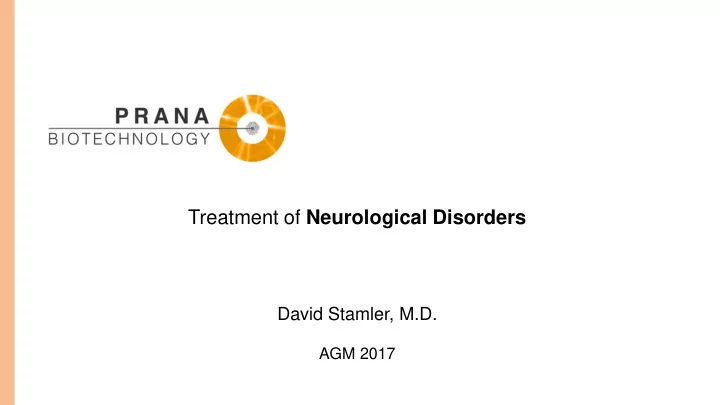

Treatment of Neurological Disorders David Stamler, M.D. AGM 2017
Highlights NOVEL DRUG CANDIDATE: PBT434 ▪ Targets key protein implicated in neurodegeneration of Parkinson’s disease and atypical parkinsonism ▪ Prevents accumulation and aggregation of α -synuclein ▪ Well tolerated in repeated dose toxicology studies STRONG RESEARCH AND DEVELOPMENT ▪ Innovative discovery program ▪ Development team with proven track record ▪ Long standing collaborations with Harvard and Florey Institute of Neuroscience and Mental Health MULTIPLE INDICATION OPPORTUNITY ▪ PBT434 active in multiple animal models of Parkinson’s disease and atypical parkinsonism 2
Rapidly Growing Burden of Neurological Disease based on Aging Population “Because the incidence of PD increases sharply with age and because the world’s population is aging, the number of individuals affected is poised for exponential growth.” Dorsey, Bloem. JAMA Neurology Published online November 13, 2017 3
PBT434 – Strong Development Rationale • PBT434 is a 2 nd generation drug to emerge from Prana’s research program • Distinct chemical scaffold and biological profile compared to prior drug candidates • Excellent drug candidate based on physical characteristics • PBT434 targets α -synuclein, a biologically important protein implicated in neurodegenerative diseases • Widespread acceptance in scientific community • PBT434 inhibits iron-mediated α -synuclein accumulation, preserves neurons and improves function in animal models of synucleinopathy • There is a strong link between iron and the synucleinopathies • Phase 2 data with a related compound demonstrates proof of concept in Parkinson’s disease • Clear development path for symptomatic therapy • Potential path for disease modifying therapy for the synucleinopathies 4
α -Synuclein is an Important Disease Target Strong Genetic and Pathological Link to Disease “Collectively these data strongly suggest that alpha synuclein is a potentially important and novel target of candidate neuroprotective therapies. Several different therapeutic strategies designed to clear or prevent the formation of toxic forms of α -synuclein are currently being investigated in the laboratory, and clinical trials have already begun.” Prana commences research collaboration with Takeda for the treatment of Parkinson’s disease gastrointestinal neuropathology 18 July 2017 AstraZeneca and Takeda establish collaboration to develop and commercialise MEDI1341 for Parkinson’s disease 29 August 2017 https://www.michaeljfox.org/research/priority-area-detail.php?alpha-synuclein 5
PBT434 Lowers α -Synuclein and Prevents Neuronal Death Transgenic Animal Model (hA53T) of PD ↓ α -Synuclein aggregation Preserves neurons in S. nigra Improves Motor Function * * 6 8 0 0 0 * * 1 0 0 T o t a l S N p c n e u r o n s P < 0 . 0 0 1 n y 4 C l a s p i n g s - 4 0 0 0 T 5 0 3 5 A 2 % h 0 0 0 W / T V e h i c l e P B T 4 3 4 V e h i c l e P B T 4 3 4 V E H P B T 4 3 4 Treatment • 4-8 months of age 30 mg/kg/day (via feed) • 6 Finkelstein et al. Acta Neuropath Comm (2017) 5:53
Strategy Supported by Proof of Concept with Deferiprone 6 month placebo controlled data in Parkinson’s disease patients Brain Iron by MRI Motor Function – UPDRS III DFP Fe binding Affinity Kb=10 36 Improvement S. nigra S. nigra DFP PBO DFP PBO Reducing excess iron improves motor function 7 Devos et al. Antiox. and Redox Signaling. 2014; 21: 195
Summary • PBT434 targets α -synuclein, a biologically important protein implicated in neurodegenerative diseases • Iron is increased in the brain of patients with target diseases • PBT434 restores iron homeostasis and blocks the accumulation and aggregation of this protein • PBT434 has shown clear efficacy in multiple animal models of disease • Potential indications include the synucleinopathies • Significant unmet needs in treating certain Orphan diseases, e.g., Multiple System Atrophy • Urgent need for disease modifying therapies • Phase 1 study to commence in mid-2018 8
Recommend
More recommend